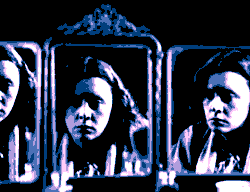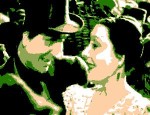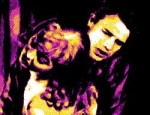Film Review
Germaine Dulac had made a dozen films (mostly now lost or forgotten)
before she directed one of the two cinematic marvels for which is now
justly remembered -
La Souriante
Madame Beudet (a.k.a.
The
Smiling Madame Beudet). In contrast to her subsequent
surreal masterpiece,
La Coquille et le clergyman
(1928), this film has a stark reality to it and powerfully expresses
the ennui and sense of confinement experienced by most members of
Dulac's sex at the time it was made. A staunch feminist, Dulac
was highly attuned to the raw deal that women had in a male-oriented
society (in France, women were not allowed to vote in national
elections before 1944) and she became a standard bearer for the modern
liberated women by pursing an active career in an industry that was
almost exclusively the preserve of the male sex. In her most
overtly feminist film, Dulac provides a grimly comedic evocation of the
despair of a woman shackled to a life of grudging servitude through the
bonds of marriage and social convention.
Dulac's approach is an example of impressionism, a style of cinema
developed by Dulac and her French avant-garde contemporaries that
relies more on framings, camera effects and angles than
mise-en-scène to express visually the mental states of the
characters. It is a form of subjective cinema that differs subtly
from expressionism, which achieves a similar effect through set design,
lighting, acting style and shot composition. The most apparent
examples of impressionistic technique in Dulac's film include the use
of slow motion and lens distortion in the sequence where Madame
Beudet's husband appears to her in a dream-like flight of fancy and
threatens her with lascivious intent. Earlier in the film, the
heroine imagines a tennis player attacking her husband and dragging him
off - this is realised using superimposition, a device often used by
the French impressionist filmmakers (notably Abel Gance). These
impressionistic touches not only add to the film's distinctive poetry,
they also stress the intense antagonism that Madame Beudet feels for
her husband and her almost psychotic yearning to be rid of him.
Some moody lighting blurs the boundary between imagined fantasy and the
nightmare reality that overtakes Madame Beudet
as she loads the gun with bullets that she knows will shatter her
husband's brain. At the end of the film, once the drama has
resolved itself, a puppet show is projected onto a wall as a glib
parody of a happy marriage, and we realise that this is how Madame
Beudet sees herself - a pathetic guignol forever condemned to enact a
ritual of simulated contentment in a theatre for children. In any
other film, the very last shot would have implied "And they lived
happily ever after" but here it says the complete opposite.
The smile of Madame Beudet is not that of a fulfilled woman but rather that
we would expect to see on the face of a condemned man.
© James Travers 2015
The above content is owned by frenchfilms.org and must not be copied.
Film Synopsis
Madame Beudet leads a melancholic and unfulfilled life, trapped in a
loveless marriage to a draper who neglects and subjugates her.
She has grown weary of her husband's childish stunts, such as
threatening to shoot himself in the head with an unloaded revolver, and
she yearns to be set free and start a new life before it is too
late. After a row with her husband, Madame Beudet decides she can
endure this life no longer. Whilst he is out at the theatre, she
loads her husband's gun with bullets, knowing that the next time he
performs his stunt he will kill himself. After a sleepless night
she has a change of heart, but before she can remove the bullets from
the gun her husband gets there first. As he chastises his wife
for her poor housekeeping, Monsieur Beudet picks up the gun, aims it at
her and, not knowing it is loaded, pulls the trigger...
© James Travers
The above content is owned by frenchfilms.org and must not be copied.



